Humphrey Bogart
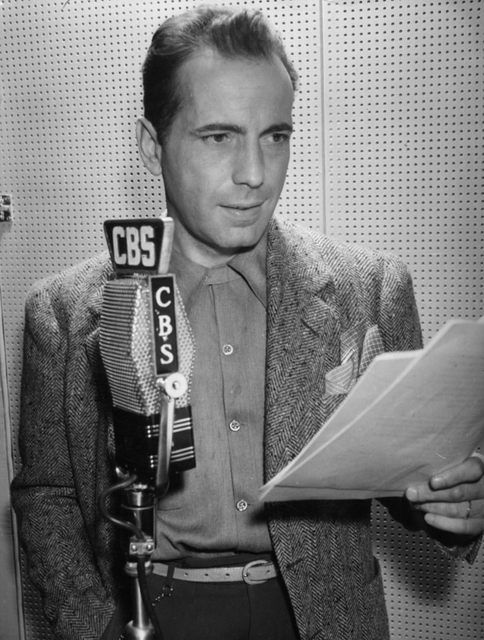
Humphrey Bogart

| Born | |
|---|---|
| Died | January 14, 1957 (aged 57) |
| Resting place | Forest Lawn Memorial Park |
| Education | Trinity SchoolPhillips Academy |
| Occupation | Actor |
| Years active | 1921–1956 |
| Height | 5 ft 8 in (173 cm) |
| Children | 2 |
| Parent(s) | Belmont DeForest Bogart, M.D.Maud Humphrey |
| Awards | |
| Military career | |
| Allegiance | |
| Service/branch | United States Navy |
| Years of service | 1918–unknown |
| Battles/wars | World War I |
| Website | |
| Signature | |
Humphrey DeForest Bogart (/ˈboʊɡɑːrt/;[1] December 25, 1899 – January 14, 1957)[2][3] was an American film and theater actor. His performances in numerous films from the Classical Hollywood era made him a cultural icon.[4][5][6] In 1999, the American Film Institute selected him as the greatest male star of classic American cinema.[7]
Bogart began acting in Broadway shows[8] and began his movie career in Up the River (1930). The film also starred Spencer Tracy. Bogart played the romantic role in a part as large as Tracy's, despite Bogart's much lower billing. Bogart appeared in various supporting parts for several years, sometimes portraying gangsters due to his resemblance to John Dillinger. He was highly praised for his work in The Petrified Forest (1936), which was his big break into the Warner Bros. gangster pantheon.
Bogart's breakthrough from supporting roles to A-list stardom came with High Sierra (1941), his last role as a gangster, and The Maltese Falcon (1941), considered to be one of the first great film noirs.[9]*Film%3A%20An%20International%20Hist]]is private detectives Sam Spade in and Phillip Marlowe in The Big Sleep model for detectives in other film noirs. His first true romantic lead role came when he appeared alongside Ingrid Bergman in Casablanca (1942), although filming the pair involved efforts to mask the fact Bergman was taller than the 5'8" (1.73 m) Bogart. Casablanca, a Best Picture Academy Award Winner, landed him his first nomination for the Academy Award for Best Actor.
Bogart and 19-year-old Lauren Bacall fell in love when they filmed To Have and Have Not (1944) and soon after the main filming for The Big Sleep (1946), their second film together, concluded in early 1945, he filed for divorce from his first wife and married Bacall. After their marriage, she also played his love interest in Dark Passage (1947), and Key Largo
Bogart's performances in The Treasure of the Sierra Madre (1948), as a paranoid gold prospector, and In a Lonely Place (1950), as a screenwriter suspected of murder, are today considered to be his best, although they were not as recognized at their time of release.[10] The unsettled, sometimes terrifying character he portrayed in these roles is again illustrated in his World War II war boat commander in The Caine Mutiny
It was for his cantankerous transport boat pilot alongside Katharine Hepburn's missionary in the World War I adventure The African Queen (1951) for which Bogart won the Academy Award for Best Actor. In his later years significant roles included competing with William Holden for Audrey Hepburn in Sabrina (1954) and The Barefoot Contessa with Ava Gardner. A heavy smoker and drinker, Bogart died from esophageal cancer in January 1957.
| Born | |
|---|---|
| Died | January 14, 1957 (aged 57) |
| Resting place | Forest Lawn Memorial Park |
| Education | Trinity SchoolPhillips Academy |
| Occupation | Actor |
| Years active | 1921–1956 |
| Height | 5 ft 8 in (173 cm) |
| Children | 2 |
| Parent(s) | Belmont DeForest Bogart, M.D.Maud Humphrey |
| Awards | |
| Military career | |
| Allegiance | |
| Service/branch | United States Navy |
| Years of service | 1918–unknown |
| Battles/wars | World War I |
| Website | |
| Signature | |
Early life and education
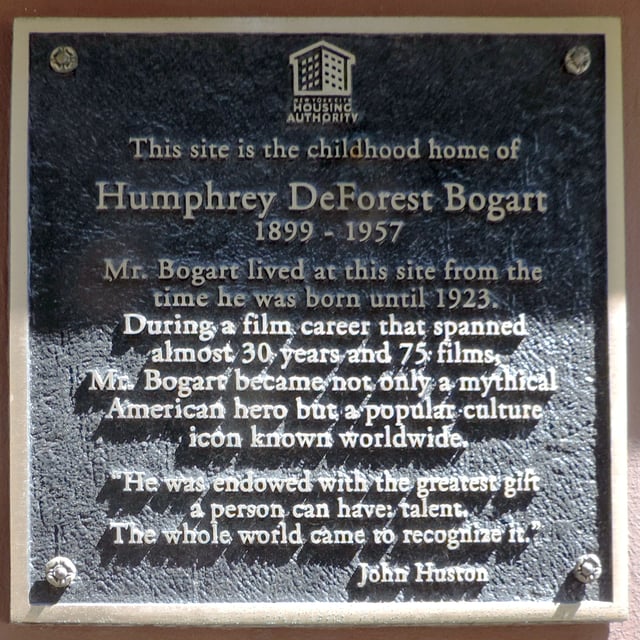
Birthplace plaque
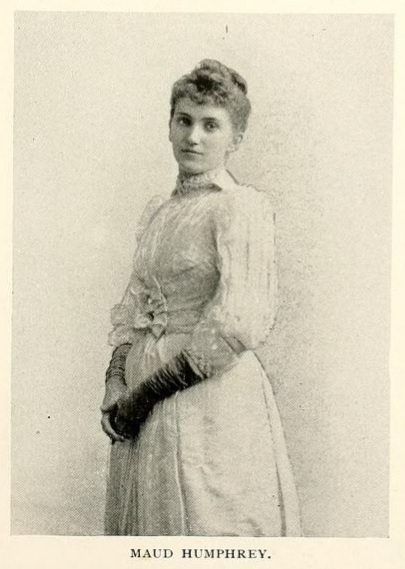
Maud Humphrey from American Women, 1897
Bogart was born on Christmas Day 1899 in New York City, the eldest child of Belmont DeForest Bogart (1867–1934) and Maud Humphrey (1868–1940). Belmont was the only child of the unhappy marriage of Adam Welty Bogart, a Canandaigua, New York innkeeper, and his wife, Julia Augusta Stiles, a wealthy heiress.[11] The name "Bogart" derives from the Dutch surname "Bogaert".[12] Belmont and Maud married in June 1898. Belmont was a Presbyterian, of English and Dutch descent, and a descendant of Sarah Rapelje, the first European child born in New Netherland. Maud was an Episcopalian of English heritage, and a descendant of Mayflower passenger John Howland. Young Humphrey was himself raised as Episcopalian, but was non-practicing for most of his adult life.[13]
The precise date of Bogart's birth was long a matter of dispute, but has been cleared up.
Warner Bros. listed his birthdate, throughout his career, but Clifford McCarty maintained that the studio publicity department had altered it from January 23, 1900 "to foster the view that a man born on Christmas Day couldn't really be as villainous as he appeared to be on screen".[14] The "corrected" January birthdate subsequently appeared—and in some cases, remains—in many otherwise authoritative sources.[15][16] Biographers Ann M. Sperber and Eric Lax documented, however, that Bogart always celebrated his birthday on December 25, and consistently listed it as such on official records, such as his marriage license.[17]
Lauren Bacall confirmed in her autobiography that his birthday was always celebrated on Christmas Day, adding that he joked that he was cheated out of a present every year because of it.[18] Sperber and Lax also noted that a birth announcement, printed in the Ontario County Times on January 10, 1900, effectively rules out the possibility of a January 23 birthdate;[19] and state and federal census records from 1900 report a Christmas 1899 birthdate as well.[20]
Bogart's father, Belmont, was a cardiopulmonary surgeon.
His mother, Maud, was a commercial illustrator who received her art training in New York and France, including study with James Abbott McNeill Whistler. Later, she became art director of the fashion magazine The Delineator and a militant suffragette.[21] She used a drawing of baby Humphrey in a well-known advertising campaign for Mellins Baby Food.[22] In her prime, she made over $50,000 a year, then a vast sum and far more than her husband's $20,000.[23] The Bogarts lived in a fashionable Upper West Side apartment, and had an elegant cottage on a 55-acre estate on Canandaigua Lake in upstate New York. As a youngster, Humphrey's gang of friends at the lake would put on theatricals.[24]
Bogart had two younger sisters, Frances ("Pat") and Catherine Elizabeth ("Kay").[22] His parents were busy in their careers and frequently fought.
Very formal, they showed little emotion towards their children.
Maud told her offspring to call her "Maud" not "Mother", and showed little if any physical affection for them.
When pleased she "[c]lapped you on the shoulder, almost the way a man does", Bogart recalled.[25] "I was brought up very unsentimentally but very straightforwardly.
A kiss, in our family, was an event.
Our mother and father didn't glug over my two sisters and me."[26]
As a boy, Bogart was teased for his curls, tidiness, the "cute" pictures his mother had him pose for, the Little Lord Fauntleroy clothes she dressed him in, and even for the name "Humphrey".[27] From his father, Bogart inherited a tendency to needle, fondness for fishing, lifelong love of boating, and an attraction to strong-willed women.[28]
Bogart attended the private Delancey School until fifth grade, then the prestigious Trinity School.[29] He was an indifferent, sullen student who showed no interest in after-school activities.[28] Later he went to the equally elite boarding school Phillips Academy, where he was admitted based on family connections.[30] His parents hoped he would go on to Yale, but in 1918 Bogart was expelled.[31] Several reasons have been given: one claims that it was for throwing the headmaster (or a groundskeeper) into Rabbit Pond on campus. Another cites smoking, drinking, poor academic performance, and possibly some inappropriate comments made to the staff. A third has him withdrawn by his father for failing to improve his grades. Whatever caused his premature departure, his parents were deeply dismayed and rued their failed plans for his future.[32]
Navy
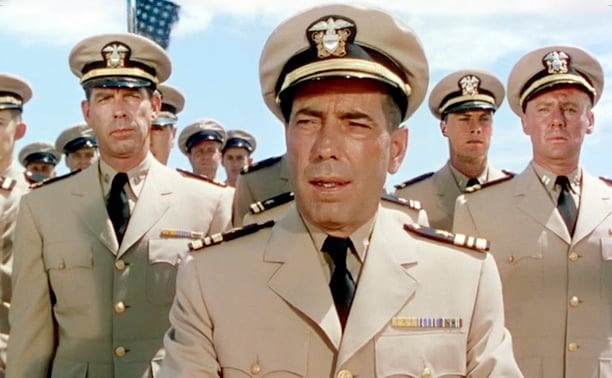
As an actor, Bogart's only major part as a US Navy man came late in his career as the paranoid Capt. Queeg in The Caine Mutiny in 1954.
With no viable career options, Bogart followed his passion for the sea and enlisted in the United States Navy in the spring of 1918, during the US involvement in World War I. He recalled later, "At eighteen, war was great stuff. Paris! Sexy French girls! Hot damn!"[33] Bogart is recorded as a model sailor who spent most of his sea time after the Armistice ferrying troops back from Europe.[34]
Bogart may have received his trademark scar and developed his characteristic lisp during his naval stint, though there are several conflicting stories.
By one tale, his lip was cut by shrapnel when his ship, the USS Leviathan, was shelled (the ship was never shelled), and it is believed Bogart did not make it to sea until after the Armistice had been signed. Another version, which Bogart's longtime friend, author Nathaniel Benchley, believed, is that Bogart was injured while taking a prisoner to Portsmouth Naval Prison in Kittery, Maine. While changing trains in Boston, the handcuffed prisoner allegedly asked Bogart for a cigarette, then while Bogart looked for a match, the prisoner smashed him across the mouth with the cuffs, cutting Bogart's lip and fleeing. Recaptured, the prisoner was taken to jail. An alternative version has Bogart struck in the mouth by a handcuff loosened while freeing his charge, the other still around the prisoner's wrist.[35] By the time Bogart was treated by a doctor, a scar had already formed. David Niven said that when he first asked Bogart about his scar, he said it was caused by a childhood accident. "Goddamn doctor", Bogart later told Niven, "instead of stitching it up, he screwed it up." Niven claims the stories that Bogart got the scar during wartime were made up by the studios to inject glamour. His post-service physical makes no mention of the lip scar, even though it mentions many smaller scars.[34] When actress Louise Brooks met Bogart in 1924, he had some scar tissue on his upper lip, which Brooks said that Bogart may have had partially repaired before entering films in 1930.[32] She also said his "lip wound gave him no speech impediment, either before or after it was mended."
Turn to acting
First performances
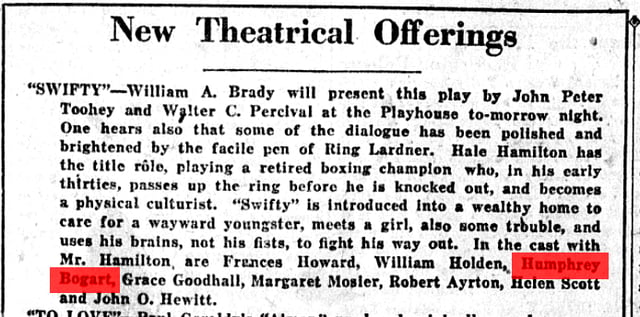
Bogart received plaudits in an October 15, 1922 newspaper review of the stage play Swifty, which stated: "Humphrey Bogart as the erring young man, Tom Proctor, did an excellent bit of work in the main".[39]
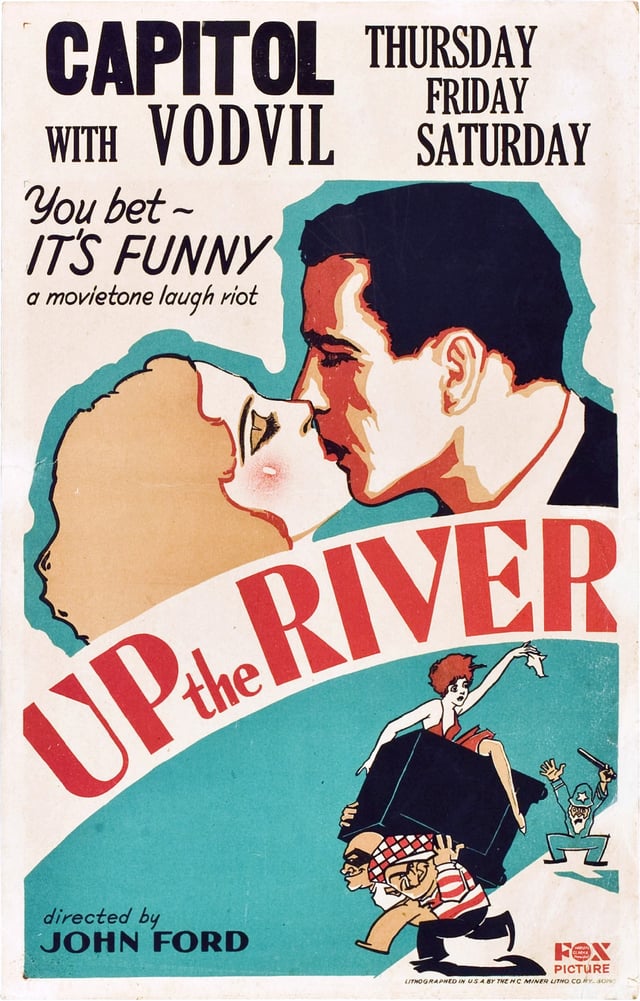
Claire Luce and Humphrey Bogart on a promotional poster for Up the River, 1930; while filming Bogart first met co-star Spencer Tracy
Bogart returned home to find his father suffering from poor health, his medical practice faltering, and much of the family's wealth lost on bad investments in timber.[36] During his naval days, Bogart's character and values developed independently of family influence, and he began to rebel somewhat against their values.
He came to be a liberal who hated pretensions, phonies, and snobs, and at times defied conventional behavior and authority, traits he displayed in both life and the movies.
He did not, however, forsake good manners, articulateness, punctuality, modesty, and a dislike of being touched.[37] After his naval service, he worked as a shipper and then bond salesman.[38] He joined the Coast Guard Reserve.
Bogart resumed his friendship with Bill Brady, Jr., whose father had show business connections.
Bogart got an office job, working for William A. Brady Sr.'s new company, World Films.[40] Bogart wanted to try his hand at screenwriting, directing, and production, but excelled at none. For a while he was stage manager for Brady's daughter Alice's play A Ruined Lady. A few months later he made his stage debut as a Japanese butler in Alice's 1921 play Drifting, nervously speaking one line of dialogue. Several appearances followed in her subsequent plays.[41]
While Bogart had been raised to believe that acting was beneath a gentleman, he liked the late hours actors kept and enjoyed the attention gotten on stage.
He stated, "I was born to be indolent and this was the softest of rackets."[38] He spent a lot of his free time in speakeasies and became a heavy drinker. A barroom brawl during this time joins the list of purported causes of Bogart's lip damage, and coincides better with the Brooks account.[42]
Preferring to learn as he went, Bogart never took acting lessons.
He was persistent and worked steadily at his craft, appearing in at least 17 Broadway productions between 1922 and 1935.[43] He played juveniles or romantic second-leads in drawing room comedies, and is said to have been the first actor to ask "Tennis, anyone?" on stage.[44] Critic Alexander Woollcott wrote of Bogart's early work that he "is what is usually and mercifully described as inadequate."[45] Some reviews were kinder.
Heywood Broun, reviewing Nerves wrote, "Humphrey Bogart gives the most effective performance... both dry and fresh, if that be possible".[46] He played juvenile lead, reporter Gregory Brown, in the comedy Meet the Wife, written by Lynn Starling, which had a successful run of 232 performances at the Klaw Theatre from November 1923 through July 1924. Bogart loathed these trivial, effeminate parts he had to play early in his career, calling them "White Pants Willie" roles.[47]
Early in his career, while playing double roles in the play Drifting at the Playhouse Theatre in 1922, Bogart met actress Helen Menken. They were married on May 20, 1926, at the Gramercy Park Hotel in New York City. Divorced on November 18, 1927, they remained friends.[48] In the divorce filing, Menken avers that Bogart valued his career more than marital happiness, also citing neglect and abuse.[49] On April 3, 1928, he married Mary Philips, whom he'd met when they appeared in the play Nerves during its very brief run at the Comedy Theatre in September 1924, at her mother's apartment in Hartford, Connecticut.
After the stock market crash of 1929, stage production dropped off sharply, and many of the more photogenic actors headed for Hollywood. Bogart's film debut was with Helen Hayes in the 1928 two-reeler The Dancing Town, of which a complete copy has never been found. He also appeared with Joan Blondell and Ruth Etting in a Vitaphone short, Broadway's Like That (1930) which was re-discovered in 1963.[50]
Broadway to Hollywood
Bogart then signed a contract with the Fox Film Corporation for $750 a week. There he met Spencer Tracy, a serious Broadway actor whom Bogart liked and admired, and they became close friends and drinking companions. It was Tracy, in 1930, who first called him "Bogie".[51] Tracy made his film debut in the only film in which he and Bogart appeared together, John Ford's early sound film Up the River (1930). Both had major roles as inmates. Tracy received top billing and Bogart's face was featured on the film's posters instead of Tracy's.[52]
Bogart shuttled back and forth between Hollywood and the New York stage from 1930 to 1935, suffering long periods without work.
His parents had separated, his father dying in 1934 in debt, which Bogart eventually paid off.
Bogart inherited his father's gold ring which he always wore, even in many of his films.
At his father's deathbed, Bogart finally told him how much he loved him.[55] His second marriage was on the rocks, and he was less than happy with his acting career.
He became depressed, irritable, and drank heavily.[19]
To Hollywood permanently: The Petrified Forest
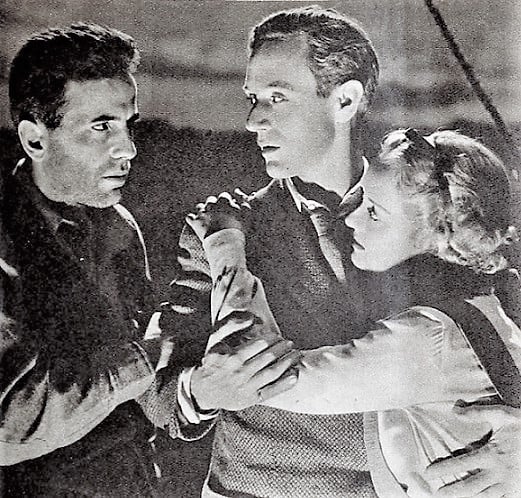
Bogart, Leslie Howard, and Bette Davis in The Petrified Forest
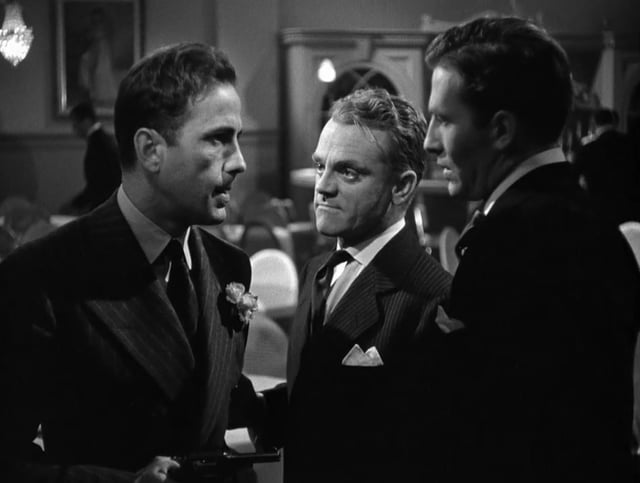
Bogart with James Cagney and Jeffrey Lynn in The Roaring Twenties
In 1934, Bogart had starred in the Broadway play Invitation to a Murder at the Theatre Masque (renamed the John Golden Theatre in 1937). The producer, Arthur Hopkins, heard the play from off-stage and was interested. He sent for Bogart, and offered him the role of escaped murderer Duke Mantee in Robert E. Sherwood's forthcoming play, The Petrified Forest.[19] Hopkins later recalled:
When I saw the actor I was somewhat taken aback, for [I realized] he was the one I never much admired.
He was an antiquated juvenile who spent most of his stage life in white pants swinging a tennis racquet.
He seemed as far from a cold-blooded killer as one could get, but the voice[,] dry and tired[,] persisted, and the voice was Mantee's.[56]
The play had 197 performances at the Broadhurst Theatre in New York in 1935.[57]
Although Leslie Howard was the star, The New York Times critic Brooks Atkinson said the play was "a peach... a roaring Western melodrama... Humphrey Bogart does the best work of his career as an actor."[58] Bogart said that the play "marked my deliverance from the ranks of the sleek, sybaritic, stiff-shirted, swallow-tailed 'smoothies' to which I seemed condemned to life." This, however, did not mean he now felt secure.[57]
Warner Bros. bought the screen rights to The Petrified Forest in 1935.[59] The play seemed ideal for the studio, which was known for its socially realistic pictures, especially for a public entranced by real-life criminals like John Dillinger[60] and Dutch Schultz.[61] Bette Davis and Leslie Howard were cast. Howard, who held production rights, made it clear he wanted Bogart to star with him.
The studio tested several Hollywood veterans for the Duke Mantee role, and chose Edward G. Robinson, who had first-rank star appeal and was due to make a film to fulfill his contract. Bogart cabled news of this development to Howard in Scotland, who replied: "Att: Jack Warner Insist Bogart Play Mantee No Bogart No Deal L.H.". When Warner Bros. saw Howard would not budge, they gave in and cast Bogart.[62] Jack Warner wanted Bogart to get his stage name, but Bogart declined it.[63]
The film version of The Petrified Forest was released in 1936. Variety said "Bogart's menace leaves nothing wanting".[64] and Frank S. Nugent in The New York Times wrote that the actor "can be a psychopathic gangster more like Dillinger than the outlaw himself."[65] The film was successful at the box-office, earning $500,000 in rentals, and made Bogart a star.[66] He never forgot Howard's favor, and in 1952 named his only daughter "Leslie Howard Bogart" after him.
Supporting roles as gangsters and villains
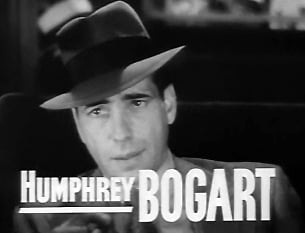
Still from the Invisible Stripes
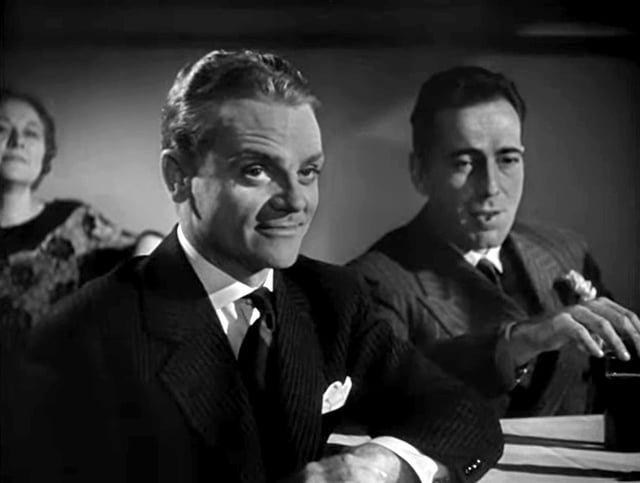
Taking a back seat to James Cagney in The Roaring Twenties
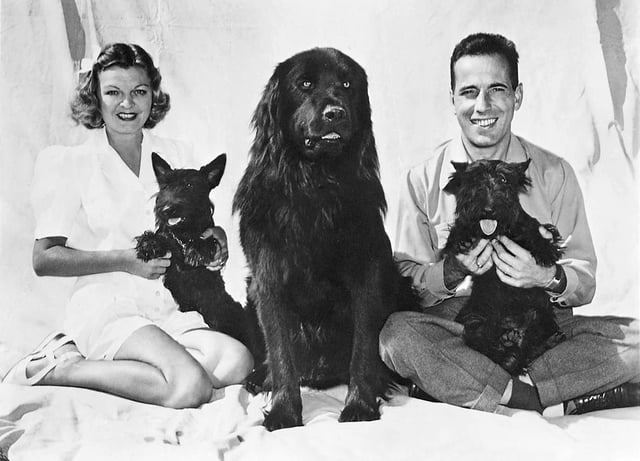
Methot and Bogart with their dogs (1944)
Despite his success in The Petrified Forest, an "A movie", Bogart received a tepid 26-week contract at $550 per week and was typecast as a gangster in a series of "B movie" crime dramas.[67] Bogart was proud of his success, but the fact that it came from playing a gangster weighed on him. He once said: "I can't get in a mild discussion without turning it into an argument. There must be something in my tone of voice, or this arrogant face—something that antagonizes everybody. Nobody likes me on sight. I suppose that's why I'm cast as the heavy."
In spite of his success, Warner Bros.
had no interest in making Bogart a top star.
His roles were not only repetitive, but physically demanding and draining (studios were not yet air-conditioned), and his regimented, tightly scheduled job at Warners was anything but the indolent and "peachy" actor's life he hoped for.[68] Bogart disliked the roles chosen for him, but he worked steadily. "In the first 34 pictures" for Warner's, he told George Frazier "I was shot in 12, electrocuted or hanged in 8, and was a jailbird in 9".[69] Between 1936 and 1940, he averaged a film every two months, at times working on two simultaneously. He used these years to start developing his enduring film persona—the wounded, stoical, cynical, charming, vulnerable, self-mocking loner with a code of honor.
Amenities at Warners were few compared to the prestigious Metro-Goldwyn-Mayer. Bogart thought that the Warners wardrobe department was cheap, and often wore his own suits in his movies. In High Sierra, Bogart used his own pet dog Zero to play his character's dog, Pard. His disputes with Warner Bros. over roles and money were similar to those the studio waged with other high-spirited, less-than-obedient stars, such as Bette Davis and James Cagney.[70]
The leading men ahead of Bogart at Warner Bros.
included such marquee names as James Cagney and Edward G. Robinson. Most of the studio's better movie scripts went to them or others, leaving Bogart with what was left. He made films like San Quentin (1937), Racket Busters (1938), and You Can't Get Away with Murder (1939). The only substantial leading role he got during this period was in Dead End (1937), while loaned to Samuel Goldwyn, where he portrayed a gangster modeled after Baby Face Nelson.[71]
Bogart played violent roles so often that in Nevil Shute's novel What Happened to the Corbetts (1939) the protagonist, when asked whether he knows how to operate an automatic weapon, jokes "I've seen Humphrey Bogart with one often enough".[72] He did play a variety of interesting supporting roles, such as in Angels with Dirty Faces (1938). Repeatedly, Bogart's roles were either rivals of characters played by Cagney and Edward G. Robinson, or a secondary member of their gang.[69] In Black Legion (1937), for a change, he played a good man caught up and destroyed by a racist organization, a movie Graham Greene described as "intelligent and exciting, if rather earnest".[73]
The studio cast Bogart in a "hillbilly musical" called Swing Your Lady (1938) as a wrestling promoter; he later apparently considered this his worst film performance.[74] Bogart played what turns out to be a rejuvenated, formerly dead scientist in The Return of Doctor X (1939), his only horror film. He cracked, "If it'd been Jack Warner's blood... I wouldn't have minded so much. The trouble was they were drinking mine and I was making this stinking movie." During this time his wife Mary had a stage hit in A Touch of Brimstone (1935), and refused to give up her Broadway career to go to Hollywood. After the play closed she relented, but insisted on continuing her career and the couple divorced in 1937.[75]
On August 21, 1938, Bogart entered into a turbulent third marriage, with actress Mayo Methot, a lively, friendly woman when sober, but paranoid and physical when drunk. She became convinced Bogart was cheating on her (which he eventually would, with Lauren Bacall, when filming To Have and Have Not in 1944).[76] The more the two drifted apart, the more she drank, in her fury, throwing plants, crockery and anything close at hand at Bogart. She set their house on fire, stabbed him with a knife, and slashed her wrists on several occasions. Bogart, for his part, needled her, and seemed to enjoy confrontation; he was himself sometimes violent as well. The press accurately dubbed them "the Battling Bogarts".[77]
"The Bogart-Methot marriage was the sequel to the Civil War," said their friend Julius Epstein. A wag observed that there was "madness in his Methot." During this time, Bogart bought a motor launch, which he named Sluggy, his nickname for hot-tempered Methot. Bogart acknowledged that "I like a jealous wife...We get on so well together (because) we don't have illusions about each other...I wouldn't give you two cents for a dame without a temper." Louise Brooks stated, "except for Leslie Howard, no one contributed as much to Humphrey's success as his third wife, Mayo Methot."[78] However, Methot's influence was increasingly destructive,[78] and Bogart's own drinking did not help matters.[76]
Bogart had a lifelong disgust for the pretentious, fake or phony.[79] Sensitive yet caustic, he was once again disgusted by the inferior movies he was performing in.
He rarely saw his own films and avoided premieres.
He even issued phony press releases about his private life to satisfy the curiosity of newspapers and the public.[80] When he thought an actor, director, or a movie studio had done something shoddy, he spoke up about it and was willing to be quoted.
He advised Robert Mitchum that the only way to stay alive in Hollywood was to be an "againster". As a result, he was not the most popular of actors, and some in the Hollywood community shunned him privately to avoid trouble with the studios.[81] Bogart once said:[82]
All over Hollywood, they are continually advising me, "Oh, you mustn't say that.
That will get you in a lot of trouble," when I remark that some picture or writer or director or producer is no good.
I don't get it.
If he isn't any good, why can't you say so?
If more people would mention it, pretty soon it might start having some effect.
The local idea that anyone making a thousand dollars a week is sacred and is beyond the realm of criticism never strikes me as particularly sound.
The Hollywood press, however, unaccustomed to such candor, was delighted.[83]
Early stardom
High Sierra
The screenplay of High Sierra (1941), a film directed by Raoul Walsh, was written by John Huston, Bogart's friend and drinking partner. It was adapted from the novel by W. R. Burnett (writer of the novel Little Caesar was based upon).[84] Paul Muni, George Raft, Cagney and Robinson turned down the lead role,[69] giving Bogart the opportunity to play a character of some depth, although Walsh initially fought against Bogart's casting, much preferring Raft for the part. The film was Bogart's last major film playing a gangster (only a supporting role followed in The Big Shot, released in 1942). Bogart worked well with Ida Lupino, and her relationship with him was close, provoking jealousy from Bogart's wife, Mayo.[85]
The film cemented a strong personal and professional connection between Bogart and Huston.
Bogart admired and somewhat envied Huston for his skill as a writer.
Though a poor student, Bogart was a lifelong reader.
He could quote Plato, Pope, Ralph Waldo Emerson, and over a thousand lines of Shakespeare. He subscribed to the Harvard Law Review.[86] He admired writers, and some of his best friends were screenwriters, including Louis Bromfield, Nathaniel Benchley, and Nunnally Johnson. Bogart enjoyed intense, provocative conversation and stiff drinks, as did Huston. Both were rebellious and liked to play childish pranks. Huston was reported to be easily bored during production, and admired Bogart (also bored easily off-camera) not just for his acting talent but for his intense concentration on the set.[87]
The Maltese Falcon
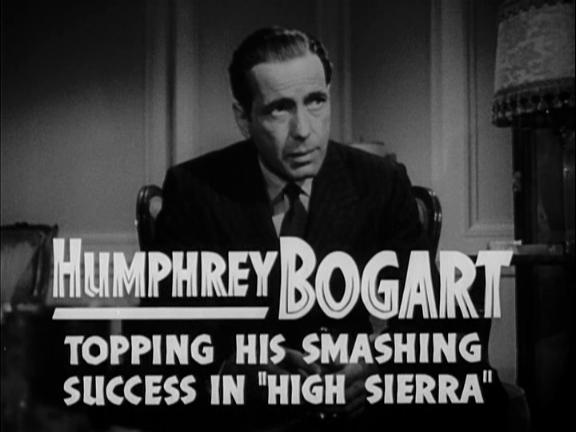
Bogart as Sam Spade in the trailer for The Maltese Falcon
Now regarded as a classic film noir, The Maltese Falcon (1941) was John Huston's directorial debut. Based on the novel written by Dashiell Hammett, it was first serialized in the pulp magazine Black Mask in 1929, and had also served as the basis of two earlier movie versions, the second being Satan Met a Lady (1936) starring Bette Davis.[88] Producer Hal B. Wallis initially offered to cast George Raft as the leading man. Raft, more established than Bogart, had a contract stipulating he was not required to appear in remakes. Fearing it would be nothing more than a sanitized version of the pre-Production Code The Maltese Falcon (1931), Raft turned down the role in order to make Manpower with director Raoul Walsh. Eagerly, Huston accepted Bogart as his Sam Spade.
Complementing Bogart were co-stars Sydney Greenstreet, Peter Lorre, Elisha Cook, Jr., and Mary Astor as the treacherous female foil.[89] Bogart's sharp timing and facial expressions were praised by the cast and director as vital to the quick action and rapid-fire dialogue.[86] The film was a huge hit in theaters and a major triumph for Huston. Bogart was unusually happy with it, remarking, "it is practically a masterpiece. I don't have many things I'm proud of... but that's one".[90]
Casablanca
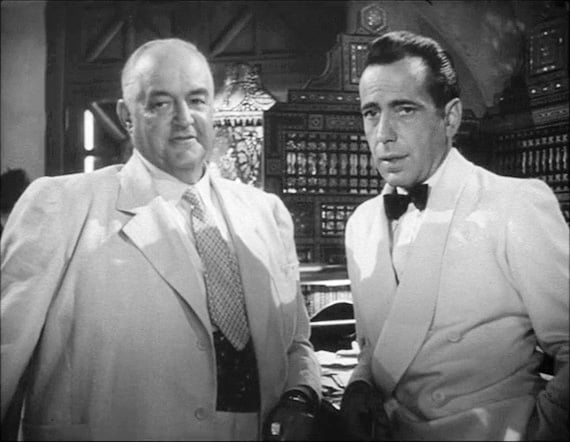
With Sydney Greenstreet in Casablanca (1942), a role that earned Bogart the first of three Oscar nominations
Bogart gained his first real romantic lead in Casablanca (1942), playing Rick Blaine, an expatriate nightclub owner hiding from a suspicious past while negotiating a fine line among Nazis, the French underground, the Vichy prefect and unresolved feelings for his ex-girlfriend. As Bosley Crowther explained in his November 1942 New York Times review, Bogart's persona is used "to inject a cold point of tough resistance to evil forces afoot in Europe today".[91] The film was directed by Michael Curtiz and produced by Hal Wallis, and featured Ingrid Bergman, Claude Rains, Sydney Greenstreet, Paul Henreid, Conrad Veidt, Peter Lorre and Dooley Wilson.
The on-screen relationship of Bogart and Bergman was the result of two actors being professional, rather than any real-life rapport, although Bogart's perennially jealous wife assumed more.
Off the set, the co-stars hardly spoke.
Bergman, who had a reputation for affairs with her leading men,[92] later said of Bogart, "I kissed him but I never knew him."[93] Because Bergman was taller, Bogart had 3-inch (76 mm) blocks attached to his shoes in certain scenes.[92]
Bogart is reported to have been responsible for the notion that Rick Blaine should be portrayed as a chess player, a metaphor for the sparring relationship he maintained with friends, enemies, and tenuous allies. In real life Bogart, played tournament level chess one division below master, often enjoying games with crew members and cast, but finding his better in the superior Paul Henreid.[94]
Casablanca won the Academy Award for Best Picture at the 16th Academy Awards for 1943. Bogart was nominated for an Academy Award Best Actor in a Leading Role, but lost to Paul Lukas for his performance in Watch on the Rhine. The film vaulted Bogart from fourth place to first in the studio's roster, finally overtaking James Cagney. By 1946, he had more than doubled his annual salary to over $460,000, making him the highest-paid actor in the world.[95]
During 1943 and 1944, Bogart went on the United Service Organizations and War Bond tours accompanied by Methot, enduring arduous travels to Italy and North Africa, including Casablanca.[95]
Bogart and Bacall
To Have and Have Not
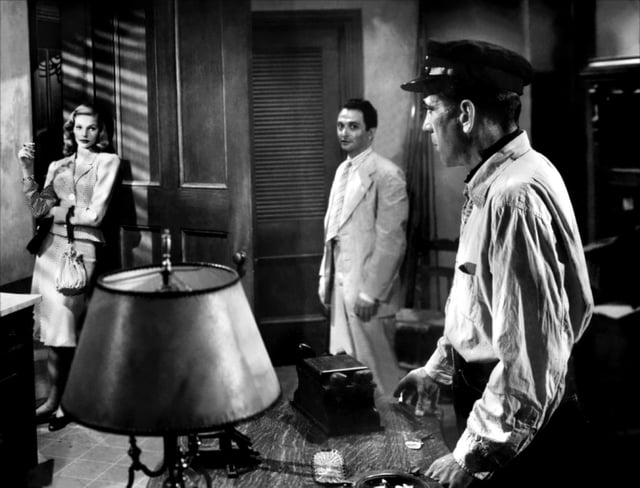
Lauren Bacall (left) and Marcel Dalio with Bogart in To Have and Have Not
Bogart met Lauren Bacall (1924–2014) while filming To Have and Have Not (1944), a loose adaptation of the Ernest Hemingway novel. The movie has many similarities with Casablanca—the same enemies, the same kind of hero, and a piano player (played by Hoagy Carmichael).[96] When they met, Bacall was 19 and Bogart 44. He nicknamed her "Baby." She had been a model since 16 and had acted in two failed plays. Bogart was drawn to Bacall's high cheekbones, green eyes, tawny blond hair, and lean body, as well as her maturity, poise and earthy, outspoken honesty.[97] Reportedly he said, "I just saw your test. We'll have a lot of fun together".[98]
Their emotional bond was very strong from the start, their age difference and disparity in acting experience allowing the dynamic of a mentor-student relationship to emerge.
Quite contrary to Hollywood norm, their affair was Bogart's first with a leading lady.[99] He was still married and his early meetings with Bacall were discreet and brief, their separations bridged by ardent love letters.[100] The relationship made it much easier for the newcomer to make her first film, and Bogart did his best to put her at ease with jokes and quiet coaching.[76] He let her steal scenes and even encouraged it. Howard Hawks, for his part, also did his best to boost her performance and highlight her role, and found Bogart easy to direct.[101]
Hawks at some point began to disapprove of the couple.[76] He considered himself Bacall's protector and mentor, and Bogart was usurping that role. Married, and not usually drawn to his starlets, he too fell for Bacall, telling her she meant nothing to Bogart and even threatening to send her to Monogram, the poverty-row studio. Bogart calmed her down and then went after Hawks. Jack Warner settled the dispute and filming resumed.[102] Hawks said of Bacall: "Bogie fell in love with the character she played, so she had to keep playing it the rest of her life."[103]
The Big Sleep

Bacall and Bogart in The Big Sleep
Just months after wrapping the film, Bogart and Bacall were reunited for an encore, the film noir The Big Sleep (1946), based on the novel by Raymond Chandler, again with script help from William Faulkner. Chandler thoroughly admired Bogart's performance: "Bogart can be tough without a gun. Also, he has a sense of humor that contains that grating undertone of contempt."[104] The film was completed and slated for release in 1945, then withdrawn and substantially re-edited to add new scenes exploiting both the box-office chemistry that shone between Bogart and Bacall in To Have and Have Not, and the publicity around their personal relationship. At director Howard Hawks' urging, production partner Charles K. Feldman agreed to Bacall's scenes being re-written to heighten the 'insolent' quality that had intrigued critics and audiences in that film.
While filming, Bogart was still torn between his new love and his sense of duty to his marriage.
The mood on the set was tense, the actors both emotionally exhausted as Bogart tried to find a way out of his dilemma.
The dialogue, especially in the newly shot scenes, was full of sexual innuendo supplied by Hawks, and Bogart proves convincing and enduring as private detective Philip Marlowe. In the end, the film was successful, though some critics found the plot confusing and overly complicated.[105] Reportedly a bemused Chandler himself could not answer baffled screenwriters' question over who killed the limousine driver early in the story.
Marriage
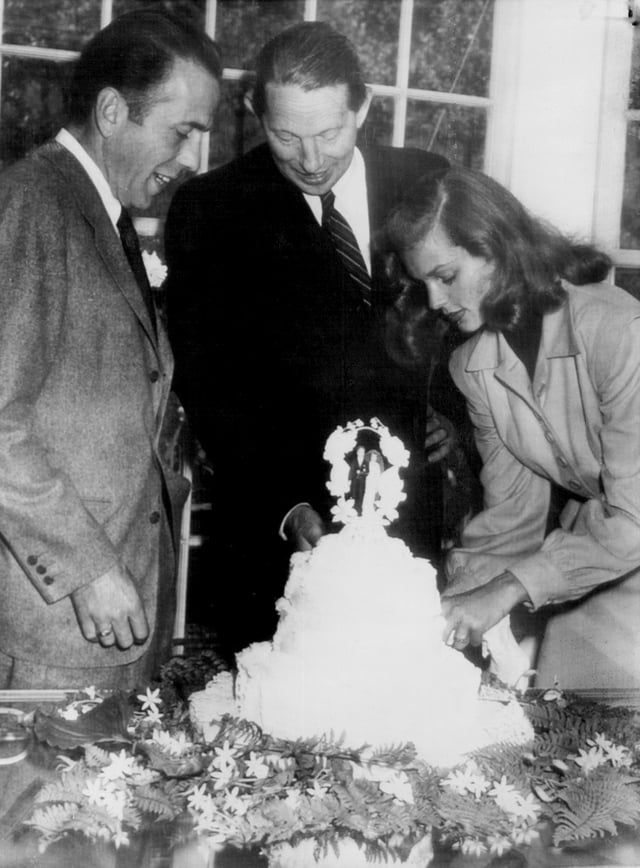
Best man Louis Bromfield (center) at the wedding of Humphrey Bogart and Lauren Bacall at Malabar Farm (May 21, 1945)
Bogart filed for divorce from Methot in February 1945.
He and Bacall married in a small ceremony at the country home of Bogart's close friend, Pulitzer Prize-winning author Louis Bromfield,[76] at Malabar Farm near Lucas, Ohio, on May 21, 1945.[66]
Bogart and Bacall moved into a $160,000 ($2,230,000 in 2018) white brick mansion in an exclusive neighborhood in Los Angeles's Holmby Hills.[106] The marriage proved a happy one, though there were tensions due to their differences. Bogart's drinking sometimes inflamed tensions.[107] He was a homebody and she liked nightlife; he loved the sea, which made her seasick.[76]
In California in 1945, Bogart bought a 55-foot (17 m) sailing yacht, the Santana, from actor Dick Powell. He found the sea a sanctuary,[108] spending about thirty weekends a year on the water, with a particular fondness for sailing around Catalina Island. He once said, "An actor needs something to stabilize his personality, something to nail down what he really is, not what he is currently pretending to be."[109] He also joined the Coast Guard Temporary Reserve offering the use of his own yacht, Santana, for Coast Guard use.[110] It was rumored Bogart attempted to enlist but was turned down because of his age.[111]
Dark Passage and Key Largo
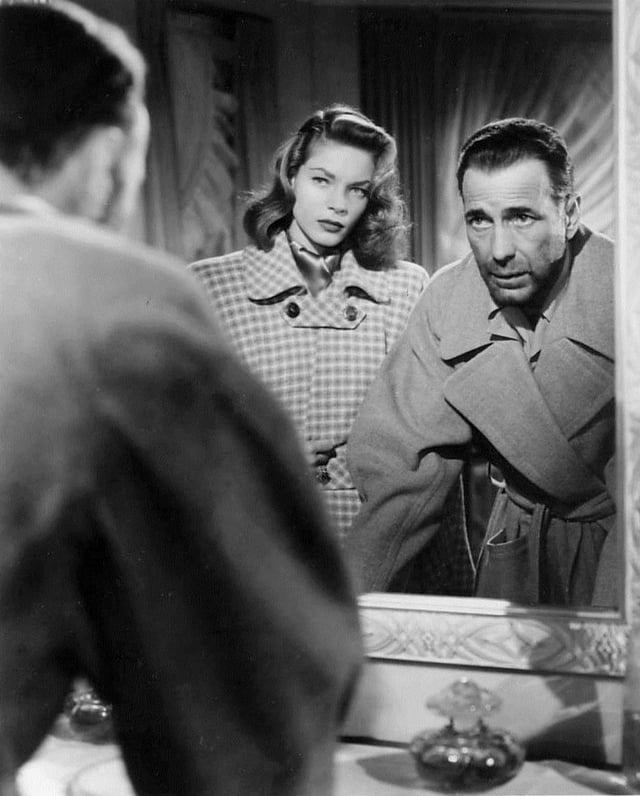
Bacall and Bogart in Dark Passage
The suspenseful Dark Passage (1947) was Bogart and Bacall's next pairing.[76] Vincent Parry (Bogart) is intent on finding the real murderer in a crime for which he was blamed and sentenced to prison.[112] Bogart's biographer Stefan Kanfer describes it as being "a production line film noir with no particular distinction".[113]
The couple's last pairing in a theatrical film was in Key Largo (1948). Directed by John Huston, the film had Edward G. Robinson billed second behind Bogart as the gangster "Johnny Rocco", a seething older synthesis of many of his vicious early bad guy roles. The characters are trapped during a spectacular hurricane in a hotel owned by Bacall's screen father-in-law, played by Lionel Barrymore. Claire Trevor won an Academy Award for Best Supporting Actress for her performance as Rocco's physically abused alcoholic girlfriend.
Later career
The Treasure of the Sierra Madre
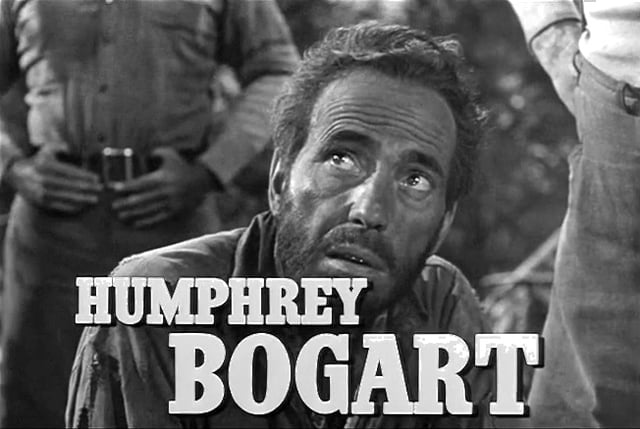
Bogart sports a trademark scruff in the trailer for The Treasure of the Sierra Madre
Riding high in 1947 with a new contract which provided limited script refusal and the right to form his own production company, Bogart reunited with John Huston for The Treasure of the Sierra Madre, a stark tale of greed played out by three gold prospectors in Mexico. Without either a love interest or happy ending it was deemed a risky project.[116] Bogart later said of co-star (and John Huston's father) Walter Huston, "He's probably the only performer in Hollywood to whom I'd gladly lose a scene."[117]
The film was shot in the heat of summer for greater realism and atmosphere, proving grueling to make.[118] James Agee wrote, "Bogart does a wonderful job with this character... miles ahead of the very good work he has done before." John Huston won the Academy Award for Best Director and screenplay and his father won Best Supporting Actor, but the film had mediocre box office results. Bogart complained, "An intelligent script, beautifully directed—something different—and the public turned a cold shoulder on it."[119]
House Un-American Activities Committee
Bogart, a liberal Democrat,[120] organized a delegation to Washington, D.C., called the Committee for the First Amendment, against what he perceived to be the House Un-American Activities Committee's harassment of Hollywood screenwriters and actors. He subsequently wrote an article "I'm No Communist" in the March 1948 edition of Photoplay magazine in which he distanced himself from The Hollywood Ten to counter the negative publicity resulting from his appearance. Bogart wrote: "The ten men cited for contempt by the House Un-American Activities Committee were not defended by us."[121]
Santana Productions
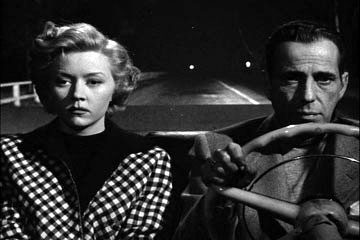
Dour as Dixon Steele, with In A Lonely Place co-star Gloria Grahame
In 1948, Bogart created his film company, Santana Productions (named after his yacht with the cabin cruiser in Key Largo).[122] Earning the right to create his own company had left Jack Warner furious, and afraid other stars would do the same and further erode the major studios' power. In addition to the pressure they were bearing from freelancing actors like Bogart, James Stewart, Henry Fonda and others, they were beginning to buckle from the eroding impact of television and enforcement of anti-trust laws breaking up theater chains.[123] Bogart performed in his final films for Warners, Chain Lightning (1950) and The Enforcer
Except for Beat the Devil (1953), originally distributed in the United States by United Artists,[124] the company released its films through Columbia Pictures, though Columbia re-released Beat the Devil a decade later.[124] Without letting up, Bogart starred in Knock on Any Door (1949), Tokyo Joe (1949), In a Lonely Place (1950), and Sirocco (1951). Santana made two other films without him: And Baby Makes Three (1949) and The Family Secret
While the majority lost money at the box office, ultimately forcing Santana's sale, at least two retain a reputation: In a Lonely Place is considered by many a high point in film noir. Bogart plays Dixon Steele, an embittered writer with a violent reputation landing him as the main suspect for the murder of a young woman. At the same time he falls in love with a failed actress Laurel Gray (Gloria Grahame).[125] Many Bogart biographers and actress/writer Louise Brooks have felt the role is the closest to the real Bogart of any he played. She wrote that the film "gave him a role that he could play with complexity, because the film character's pride in his art, his selfishness, drunkenness, lack of energy stabbed with lightning strokes of violence were shared by the real Bogart". The character even mimics some of Bogart's personal habits, including twice ordering Bogart's favorite meal of ham and eggs.[126]
Something of a parody of The Maltese Falcon, Beat the Devil was the final film for Bogart and John Huston. Co-written by Truman Capote, the eccentrically filmed tale follows an amoral group of rogues chasing an unattainable treasure.[127] Bogart sold his interest in Santana to Columbia for over $1 million in 1955.[128]
The African Queen
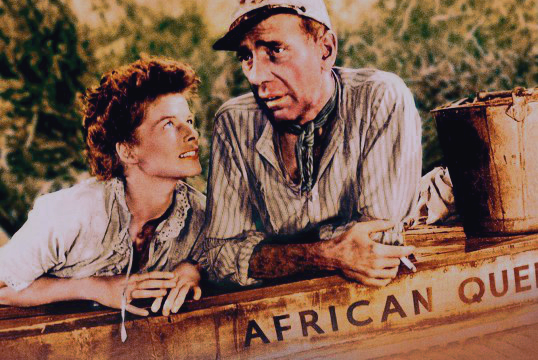
With Katharine Hepburn in a promotional image for The African Queen
Working outside of his own Santana Productions, Bogart starred with Katharine Hepburn in the John Huston directed The African Queen in 1951. The C.S. Forester novel on which it was based was overlooked and left undeveloped for 15 years until producer Sam Spiegel and Huston bought the rights. Spiegel sent Katharine Hepburn the book and she suggested Bogart for the male lead, firmly believing that "he was the only man who could have played that part".[129] Huston's love of adventure, deep, longstanding friendship—and success—with Bogart, and a chance to work with Hepburn, convinced the actor to leave the comfortable confines of Hollywood for a difficult shoot on location in the Belgian Congo in Africa. Bogart was to get 30% of the profits and Hepburn 10%, plus a relatively small salary for both. The stars met up in London and announced the happy prospect of working together.
Bacall came for the four-month-plus duration, leaving their young child to be cared for in Los Angeles.
The Bogarts started the trip with a junket through Europe, including a visit with Pope Pius XII.[130] Later, the glamor would be gone and Bacall would make herself useful as a cook, nurse, and clothes washer, earning her husband's praise: "I don't know what we'd have done without her. She Luxed my undies in darkest Africa."[131] Just about everyone in the cast came down with dysentery except Bogart and Huston, who subsisted on canned food and alcohol. Bogart explained: "All I ate was baked beans, canned asparagus and Scotch whisky. Whenever a fly bit Huston or me, it dropped dead."[132] Hepburn, a teetotaler in and out of character, fared worse in the difficult conditions, losing weight and at one point falling very ill. Bogart resisted Huston's insistence on using real leeches in a key scene where Charlie has to drag his steam launch through an infested marsh, until reasonable fakes were employed.[133] In the end, the crew overcame illness, soldier ant invasions, leaking boats, poor food, attacking hippos, poor water filters, fierce heat, isolation, and a boat fire to complete a memorable film.[134] Despite the discomfort of jumping from the boat into swamps, rivers and marshes the film apparently rekindled Bogart's early love of boats. On his return to California he bought a classic mahogany Hacker-Craft runabout, which he kept until his death.
The role of cantankerous skipper Charlie Allnutt won Bogart his only Academy Award in three nominations, for Best Actor in a Leading Role in 1951. Bogart considered his performance to be the best of his film career.[135] He had vowed to friends that if he won, his speech would break the convention of thanking everyone in sight. He advised Claire Trevor, when she had been nominated for Key Largo, to "just say you did it all yourself and don't thank anyone". But when Bogart won the Academy Award, which he truly coveted despite his well-advertised disdain for Hollywood, he said "It's a long way from the Belgian Congo to the stage of this theatre. It's nicer to be here. Thank you very much... No one does it alone. As in tennis, you need a good opponent or partner to bring out the best in you. John and Katie helped me to be where I am now." Despite the thrilling win and the recognition, Bogart later commented, "The way to survive an Oscar is never to try to win another one... too many stars... win it and then figure they have to top themselves... they become afraid to take chances. The result: A lot of dull performances in dull pictures."[136] The African Queen was the first Technicolor film to star Bogart.
Final roles
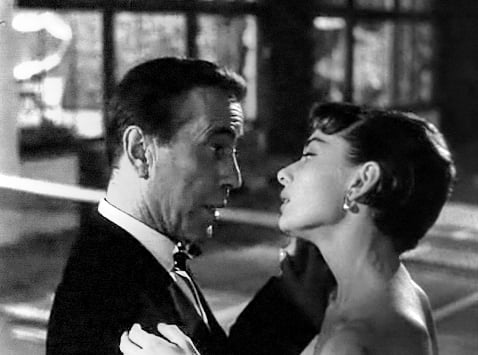
Bogart and Audrey Hepburn
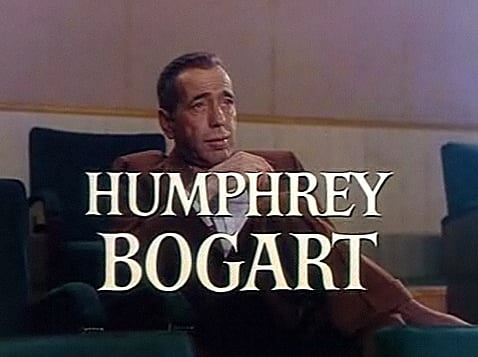
Bogart in The Barefoot Contessa

Bogart and Mike Lane in The Harder They Fall
Bogart dropped his asking price to gain the role of Captain Queeg in Edward Dmytryk's drama The Caine Mutiny (1954). Though he retained some of his old bitterness about having to do so,[137] he delivered a strong performance in the lead, earning him his final Oscar nomination as well as being the subject of the cover story in the June 7, 1954 issue of Time magazine. Yet for all his success, Bogart was still his melancholy old self, grumbling and feuding with the studio, while his health was beginning to deteriorate. The character of Queeg mirrored in some ways those Bogart had played in The Maltese Falcon, Casablanca and The Big Sleep–the wary loner who trusts no one—but without either the warmth or humor of those roles. Like his portrayal of Fred C. Dobbs in The Treasure of the Sierra Madre, Bogart played a paranoid, self-pitying character whose small-mindedness eventually destroyed him. Three months before the film's release, Bogart appeared as Queeg on the cover of Time magazine, while on Broadway Henry Fonda was starring in the stage version (in a different role), both of which generated strong publicity for the film.[138]
For Sabrina (also 1954), Billy Wilder had wished to cast Cary Grant as the older male lead. However, he chose Bogart to play the elder, conservative brother who competes with his younger playboy sibling (William Holden) for the affection of the Cinderella-like Sabrina (Audrey Hepburn). Bogart was lukewarm about the part, but agreed to it on a handshake with Wilder, sans finished script but with the director's assurances he would take good care of Bogart during the filming.[139] Nevertheless, Bogart got on poorly with his director and co-stars. He complained about the script and its last-minute drafting and delivery, and accused Wilder of favoring Hepburn and Holden on and off the set. At the root was Wilder being the opposite of Bogart's ideal director, John Huston, in both style and personality. Bogart groused to the press that Wilder was "overbearing" and "is the kind of Prussian German with a riding crop. He is the type of director I don't like to work with... the picture is a crock of crap. I got sick and tired of who gets Sabrina."[140] Wilder later claimed, "We parted as enemies but finally made up." Despite the acrimony, the film was successful. The New York Times commented that Bogart was "incredibly adroit... the skill with which this old rock-ribbed actor blends the gags and such duplicities with a manly manner of melting is one of the incalculable joys of the show".[141]
Joseph L. Mankiewicz's film, The Barefoot Contessa (again, 1954), was filmed in Rome. In this Hollywood backstory Bogart is again a broken-down man, the cynical director-narrator who saves his career by making a star of a flamenco dancer modeled on Rita Hayworth. Bogart was uneasy with Ava Gardner in the female lead, as she had just split from close "Rat Pack" buddy Frank Sinatra and was carrying on an affair with bullfighter Luis Miguel Dominguín. Bogart told her, "Half the world's female population would throw themselves at Frank's feet and here you are flouncing around with guys who wear capes and little ballerina slippers." He was also annoyed by her inexperienced performance. Later, Gardner credited Bogart with helping her both on and offscreen. Bogart's performance was generally praised as the strongest part of the film.[142] During the filming, while Bacall was home, Bogart resumed his discreet affair with Verita Bouvaire-Thompson, his long-time studio assistant, whom he took sailing and enjoyed drinking with. When his wife suddenly arrived on the scene discovering them together, she took it quite well, extracting an expensive shopping spree from her husband, the three traveling together after the shooting.[143]
Bogart could be generous with actors, particularly those who were blacklisted, down on their luck, or having personal problems.
During the filming of the Edward Dmytryk directed The Left Hand of God (1955), he noticed his co-star Gene Tierney having a hard time remembering her lines and behaving oddly. He coached Tierney, feeding her lines. He was familiar with mental illness from his sister's bouts of depression, and encouraged Tierney to seek treatment.[144] en an ugly public scandal made her persona non grata with Jack Warner.[146]
Television and radio
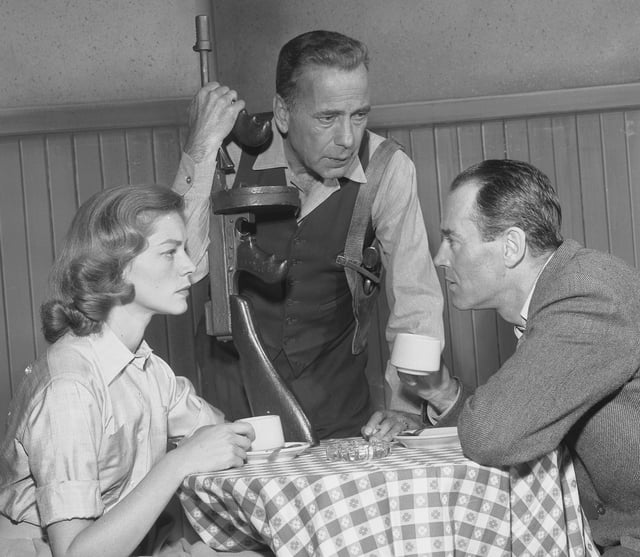
Bacall, Bogart and Henry Fonda in the television version of The Petrified Forest (1955)
While Bogart rarely performed on television, he and Bacall appeared on Edward R. Murrow's Person to Person in which they disagreed in answering every question. Bogart was also featured on The Jack Benny Show. The surviving kinescope of the live telecast captures him in his only TV sketch comedy outing. Bogart and Bacall worked together on an early color telecast in 1955, an NBC adaptation of The Petrified Forest for Producers' Showcase, with Bogart receiving top billing and Henry Fonda playing Leslie Howard's role; a black and white kinescope of the live telecast has also survived. Bogart performed radio adaptations of some of his best known films, such as Casablanca and The Maltese Falcon. He also recorded a radio series called Bold Venture
Personal life
Children
Bogart became a first-time father aged 49 when Bacall gave birth to Stephen Humphrey Bogart on January 6, 1949, during the filming of Tokyo Joe.[76] The name was drawn from Bogart's character's nickname in To Have and Have Not, "Steve".[147] Stephen later became an author and biographer, and hosted a television special about his father on Turner Classic Movies. The couple's daughter, Leslie Howard Bogart, was born on August 23, 1952, gaining her forenames from British actor Leslie Howard, Bogart's friend and co-star in The Petrified Forest.[66]Bogie%3A%20A%20Celebration%20of%20]]
Rat Pack
Bogart was a founding member and the original leader of the so-called Hollywood Rat Pack. In the spring of 1955, after a long party in Las Vegas attended by Frank Sinatra, Judy Garland, her husband Sidney Luft, Michael Romanoff and wife Gloria, David Niven, Angie Dickinson and others, Bacall surveyed the wreckage and declared, "You look like a goddamn rat pack."[148]
The name stuck and was made official at Romanoff's in Beverly Hills. Sinatra was tabbed Pack Leader; Bacall, Den Mother; Bogie, Director of Public Relations; and Sid Luft, Acting Cage Manager.[149] When asked by columnist Earl Wilson what the group's purpose was, Bacall stated: "To drink a lot of bourbon and stay up late."[148]
Illness and death
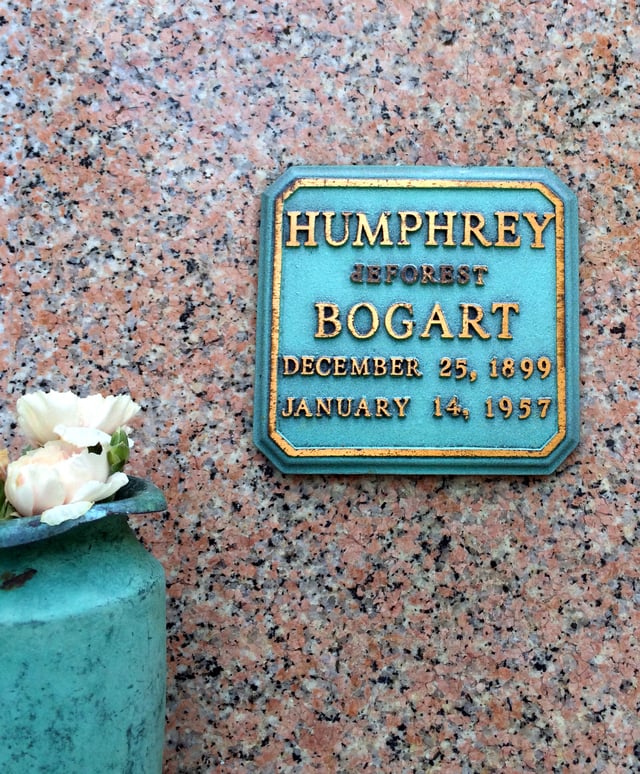
Bogart's memorial in the Garden of Memory, Forest Lawn Memorial Park Cemetery, Glendale
After signing a long-term deal with Warner Bros., Bogart predicted with glee that his teeth and hair would fall out before the contract ended.
In 1955, though he was well established as an independent producer, his health was failing.
In the wake of Santana, Bogart had formed a new company and had eager plans for a film, Melville Goodwin, U.S.A., in which he would play a general, and Bacall a press magnate. However, his persistent cough and difficulty eating became too serious to ignore, and he dropped the project.[150]
A heavy smoker and drinker, Bogart developed esophageal cancer. He did not speak of his health and visited a doctor in January 1956, after much persuasion from Bacall. The disease worsened several weeks later. On March 1, 1956, he underwent a surgical operation in which his entire esophagus, two lymph nodes and a rib were removed. However, the surgery failed, even with chemotherapy.[151] Bogart underwent corrective surgery in November 1956, when the cancer had spread.[66] With time, he grew too weak to walk up and down stairs, fighting the pain yet still able to joke: "Put me in the dumbwaiter and I'll ride down to the first floor in style." It was then altered to accommodate his wheelchair.[152] Sinatra, Katharine Hepburn, and Spencer Tracy visited Bogart on January 13, 1957. In an interview, Hepburn said:
Spence patted him on the shoulder and said, "Goodnight, Bogie."
Bogie turned his eyes to Spence very quietly and with a sweet smile covered Spence's hand with his own and said, "Goodbye, Spence."
Spence's heart stood still.
He understood.[153]
Bogart fell into a coma and died on the next day.
He had just turned 57 years old 20 days prior and weighed only 80 pounds (36 kg).
His simple funeral was held at All Saints Episcopal Church, with musical selections from favorite composers Johann Sebastian Bach and Claude Debussy. The ceremony was attended by some of Hollywood's biggest stars, including Hepburn, Tracy, Judy Garland, David Niven, Ronald Reagan, James Mason, Bette Davis, Danny Kaye, Joan Fontaine, Marlene Dietrich, James Cagney, Errol Flynn, Gregory Peck, Gary Cooper, Billy Wilder and studio head Jack L. Warner. Bacall asked Tracy to give the eulogy, but he was too upset, so John Huston spoke instead. He reminded the gathered mourners about Bogart:
Himself, he never took too seriously—his work most seriously.
He regarded the somewhat gaudy figure of Bogart, the star, with an amused cynicism; Bogart, the actor, he held in deep respect...
In each of the fountains at Versailles there is a pike which keeps all the carp active; otherwise they would grow overfat and die.
Bogie took rare delight in performing a similar duty in the fountains of Hollywood.
Yet his victims seldom bore him any malice, and when they did, not for long.
His shafts were fashioned only to stick into the outer layer of complacency, and not to penetrate through to the regions of the spirit where real injuries are done...
He is quite irreplaceable.
There will never be another like him.[154]
Bogart's cremated remains were interred in Forest Lawn Memorial Park Cemetery, Glendale, California, in the Garden of Memory, Columbarium of Eternal Light. He was buried with a small, gold whistle once part of a charm bracelet he had given to Lauren Bacall before they had married. On it was inscribed an allusion to a line from the film To Have and Have Not, which Bacall had said to him shortly after their first meeting: "You know how to whistle, don't you, Steve? You just put your lips together and blow." The inscription read: "If you want anything, just whistle."[155]
Awards and honors
On August 21, 1946, Bogart was honored in a ceremony at Grauman's Chinese Theater to record his hand and footprints in cement. On February 8, 1960, he was posthumously inducted into the Hollywood Walk of Fame with a motion pictures star located at 6322 Hollywood Boulevard.[157]
| Year | Award | Film | Result |
|---|---|---|---|
| 1943 | Best Actor | Casablanca | Nominated |
| 1951 | Best Actor | The African Queen | Won |
| 1954 | Best Actor | The Caine Mutiny | Nominated |
Legacy and tributes

Street art with Bogart and Bacall, Spain (2015)
After his death, a "Bogie Cult" formed at the Brattle Theatre in Cambridge, Massachusetts,[158] as well as Greenwich Village, Manhattan, New York, and in France, which contributed to his spike in popularity in the late 1950s and 1960s. In 1997, Entertainment Weekly magazine named Bogart the number one movie legend of all time. In 1999, the American Film Institute ranked him the greatest male screen legend.
Jean-Luc Godard's Breathless (1960) was the first film to pay tribute to Bogart. Over a decade later, in the film adaptation of Woody Allen's comic paean to Bogart, Play It Again, Sam
In 1997, the United States Postal Service honored Bogart with a stamp bearing his image in its "Legends of Hollywood" series as the third figure to be recognized.[159] At a formal ceremony attended by Lauren Bacall and the Bogart children, Stephen and Leslie, Tirso del Junco, the chairman of the governing board of the USPS, provided an eloquent tribute:
"Today, we mark another chapter in the Bogart legacy.
With an image that is small and yet as powerful as the ones he left in celluloid, we will begin today to bring his artistry, his power, his unique star quality, to the messages that travel the world."[160]
On June 24, 2006, a section of 103rd Street, between Broadway and West End Avenue, in New York City was renamed "Humphrey Bogart Place".
Lauren Bacall and her son Stephen Bogart were present at the commemorative event.
"Bogie would never have believed it", Lauren Bacall expressed to the assembled group of city officials and onlookers in attendance.[161]
In popular culture
Bogart's appearance has inspired writers and others:
Two Bugs Bunny cartoons featured Bogart: In Slick Hare (1947), Bogart orders fried rabbit in a Hollywood restaurant. Told that they do not have any, he becomes insistent, leading waiter Elmer Fudd to try to serve Bugs as the meal. Eventually, Bogart gives way by saying: "Baby will just have to have a ham sandwich instead." Bugs, upon hearing the name, then presents himself to Bacall.[162] In 8 Ball Bunny (1950), Bugs decides to take a baby penguin back to the South Pole. At intervals, "Fred C. Dobbs" (Bogart's character in Treasure of the Sierra Madre) appears and asks Bugs to "help out a fellow American who's down on his luck"—similar to a line Bogart says several times in the film ("Will you stake a fellow American to a meal?") to John Huston, playing an American gringo.[163][164]
The Man with Bogart's Face (1981) was an homage to Bogart which starred Bogart lookalike Robert Sacchi.[165]
The 1981 song "Key Largo" by Bertie Higgins references both Key Largo and Casablanca in the lyrics and directly mentions Bogart and Lauren Bacall in the song's chorus ("Just like Bogie and Bacall", and "Here's looking at you kid").[166]
Filmography
Radio appearances (notable)
| Date | Program | Episode/source |
|---|---|---|
| April 17, 1939 | Lux Radio Theatre | Bullets or Ballots[167] |
| 1940 | The Gulf Screen Guild Theater | The Petrified Forest |
| 1941 | The Gulf Screen Guild Theater | If Only She Could Cook |
| 1941 | The Gulf Screen Guild Theater | The Amazing Dr. Clitterhouse |
| 1941 | The Gulf Screen Guild Theater | If You Could Only Cook |
| January 4, 1942 | The Screen Guild Theater | High Sierra[168][169] |
| 1943 | The Screen Guild Theater | Casablanca[170] |
| September 20, 1943 | The Screen Guild Theater | The Maltese Falcon[171][172] |
| 1944 | Screen Guild Players | High Sierra[173] |
| April 30, 1945 | Lux Radio Theatre | Moontide |
| July 3, 1946 | Academy Award Theater | The Maltese Falcon[172] |
| 1946 | Lux Radio Theatre | To Have and Have Not[174] |
| April 18, 1949 | Lux Radio Theatre | Treasure of the Sierra Madre |
| 1951–52 | Bold Venture | Series – 78 episodes |
| 1952 | Stars in the Air | The House on 92nd Street[175] |
| 1952 | Lux Radio Theatre | The African Queen[176] |
See also
Bogart–Bacall syndrome
List of famous amateur chess players
List of actors with Academy Award nominations